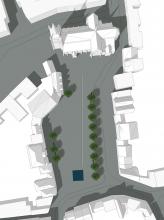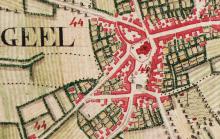Historic research shows that prior to 1880, the market square in Geel contained several valuable elements that could serve as the foundation for its remodelling. As the Ferraris map from around 1775 shows, the market place was a central empty space surrounded by lime trees, as was common with village squares in the Campines region. On the south side, an open pond or pool served as a monumental counterpart to the church on the north side, whilst also marking the end of the square.
In addition to its cultural and historical significance, the planting (or replanting) of lime trees also creates a sense of security around the central section. The importance of having drinking water or water for quelling flames in a central location has of course gone, but both the spatial qualities and the history of the square make a reconstruction of the water feature relevant too. In the design, this is achieved by placing a shallow, square, black basalt basin in the original location.
In addition to the trees and the basin, a white ground gutter with a precise north-south orientation runs over the entire length of the square towards the church. This gives this open stretch a monumental feel. Our own shadow in relation to this line shows where we are in relation to midday. The line positions us both mentally and physically in a wider scene.



